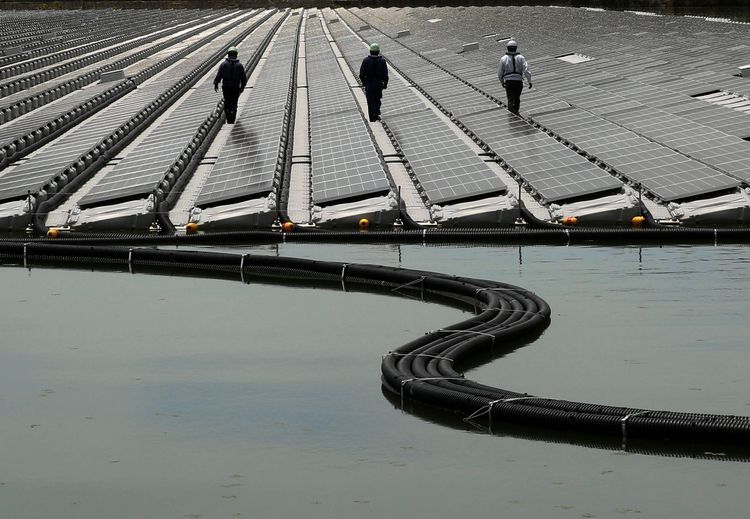
China’s ambitions to dominate new energy technologies are unfolding at the site of an abandoned coal mine about 300 miles (483 kilometers) northwest of Shanghai.
There, in Anhui province, Sungrow Power Supply Co. has built the world’s largest floating solar farm with 166,000 panels on a lake created when a nearby mine collapsed. While not an entirely unique idea — similar facilities are working in Japan, the U.K. and Israel — the project’s scale represents a step forward for China in shaping the future of energy.
President Xi Jinping’s government this week is drawing attention to those efforts at a meeting of energy ministers from around the world that concludes Thursday in Beijing. With plans to spend $360 billion on renewable energy by 2020, China is seeking to appear as a global leader on the environment, marking a contrast with U.S. President Donald Trump’s rebuke of the Paris Agreement on climate change.
“The Chinese are really investing in the research and development side of innovation,” said Helen Clarkson, chief executive officer of The Climate Group, a non-governmental organization that works to promote clean energy technologies and policy.
While Trump has said repeatedly he wants to stimulate fossil fuels and especially coal, China is funding a series of ground-breaking projects that generate power without pollution. Whether with massive floating solar farms like the one in Anhui, sprawling wind farms or ambitious plans to develop geothermal reserves, the world’s most-populous nation is asserting itself as a powerhouse of clean-energy technology.
Renewables Spending
In the northwestern province of Qinghai, Huanghe Hydropower Development Co. is planning a demonstration project to integrate power from hydro-electric dams with wind turbines and solar cells. Similarly, the Guoshen Group, a power plant operator, intends to build a project that will combine wind, solar and thermal power with energy storage in the northern region of Inner Mongolia.
Meanwhile, construction has begun on China’s first large-scale effort to trap and store carbon dioxide emissions. The Yanchang Integrated Carbon Capture and Storage Project, Asia’s first commercial carbon capture plant, is set to begin operating in 2018.
“Everybody has to become more sophisticated about their investment strategy,” said Sophie Lu, head of China research at Bloomberg New Energy Finance. “Now it’s all about innovation either in new technology or in a new application or a new business model.”
China’s efforts pit it against the U.S., which insists it can remain a hotbed of innovation in energy even though the president is slashing funds for start-ups in the industry and pulling out of the 2015 Paris accord. On his trip to Asia to represent Trump, U.S. Energy Secretary Rick Perry spoke forcefully of America’s efforts to spur energy technology while also challenging China to take leadership on the issue.
“There is a lot of innovation out there, and it is gonna come, not all of the ways, but a lot of it will come from the United States,” Perry told reporters in Tokyo. “Somehow or another, because we don’t belong to this little club, you can’t be innovative and drive technology and affect the climate. I just don’t buy it.”
Jobs Growth
The stakes are high for both nations. The clean-energy business employed 9.8 million people last year, up 1.1 percent from 2015, led by an expansion in solar photovoltaics, according to the International Renewable Energy Agency’s annual report. Green jobs may reach 24 million worldwide in 2030 as more countries work to combat climate change, Irena said.
“China is a real driver in the money they invest in the diligence of their innovation,” California Governor Jerry Brown said in a Bloomberg Television interview on Tuesday. “I want California to partner with China in that endeavor. Otherwise we won’t achieve our climate goals.”
In Anhui, Sungrow’s 40-megawatt solar farm in a district of Huainan city called Panji features panels fixed to floats on the surface of a lake that formed after the ground surrounding an old coal mine collapsed.
Floating Solar
Floating solar is spreading and getting bigger, led by projects in Asia and Europe.
Hong Kong-listed Xinyi Solar Holdings Ltd. completed a 20-megawatt floating solar farm last year in Huainan. On a reservoir outside Tokyo, Kyocera TCL Solar LLC has finished a 13.4-megawatt project, the biggest of its kind in Japan. Thames Water Utilities Ltd., the U.K.’s largest privately owned water supplier, operates Europe’s largest floating solar farm on its Queen Elizabeth Reservoir reservoir near Heathrow airport.
By the end of September, Sungrow will complete more than 150 megawatts of new floating capacity in Huainan, said Hu Bing, an executive at Sungrow, the world’s second-biggest photovoltaic inverter maker.
To be fair, China’s energy innovations still have some way to go to catch up to the country’s aspirations.
While China has 37 working nuclear reactors, none have been built without expertise from abroad. The country also hasn’t produced an innovator with a profile similar to that of Tesla Inc., General Electric Co. or Vestas Wind Systems A/S.
The U.S. plans to keep its competitive edge “the same way we have historically,” Perry said in Tokyo. “It’s called innovation and technology.”
Recommended for you
